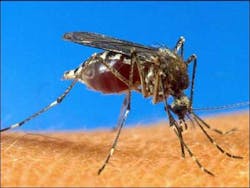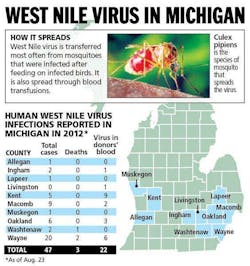The deadly West Nile virus
As of August 23, 2012, the number of cases of West Nile virus had grown dramatically and public health experts suggest that if the trend continues, this year’s outbreak may rank among the largest in U.S. history. According to data from state health departments compiled by the Centers for Disease Control and Prevention, 47 states have reported West Nile virus infections in people, birds or mosquitoes so far this year.(1) A total of 1,118 cases of West Nile virus disease in people, including 41 deaths, have been reported to CDC, which is the greatest number of cases reported through this time of year since 1999, when the virus was first detected in the United States. These data indicate that the USA is in the midst of one of the largest West Nile virus outbreaks ever seen in the United States, according to Lyle Petersen, director of CDC’s Division of Vector-borne Infectious Diseases, during a telebriefing on August 22, 2012.(2)
It's too late to beat back this year's deadly surge in the West Nile virus by starting mass pesticide efforts, leaving it up to individuals to make use of bug spray and remove stagnant water. That's a frustration for entomologists and public health officials who say mosquito-control programs have been slashed in budget cuts over the years. Michigan confirmed its second and third West Nile deaths recently, as cases nationally and statewide continued climbing to the highest levels in years. At least 47 cases have been confirmed statewide in Michigan. This is the highest number of human cases in Michigan in the season since 2002, which is the year it first appeared in humans in Michigan.(3)
Texas reports almost half of the cases in the USA. The CDC is not clear why the number of cases is greater this year than in recent years. Weather may be a contributing factor, with a mild winter followed by an early spring and a hot summer in many parts of the country possibly creating a more hospitable environment for mosquitoes, the primary mode of transmission. There is no vaccine against West Nile virus. The key to its control is killing mosquito larvae early in the year before they become adults and feast on birds, spreading the virus even faster. Mosquito-control programs, killing larvae in the spring, doing surveillance on adult mosquitoes and checking them for the virus, and organizing public awareness campaigns do work. There have, however, been concerns that massive spray efforts might trigger asthma or other health concerns. The best thing individuals can do is follow personal protection measures. Tests for West Nile virus may include blood work, computed tomography (CT) or magnetic resonance imaging (MRI) scans of the head, and lumbar puncture (spinal tap) for cerebrospinal fluid (the natural fluid that bathes the brain and spinal cord).(4) As always, prevention is the best policy.Severe Symptoms of West Nile Virus • High fever, headache, neck stiffness, stupor, disorientation, tremors, convulsions, muscle weakness, vision loss, numbness, paralysis and coma. Other Symptoms • Body aches, nausea, vomiting and, sometimes, swollen lymph glands or a skin rash on the chest, stomach and back.No Symptoms • Approximately 80% of people who are infected will not show any symptoms.Precautions for Prevention • Use insect repellent and wear long sleeves and pants. • Fix screens on your windows and doors to keep mosquitoes out. • Empty standing water from flower pots, buckets and barrels. • Change the water in pet dishes and water in birdbaths frequently. • Drill holes in tire swings to drain water. • Empty wading pools when they aren't being used. The Journal of the American Medical Association (JAMA) has prepared a Patient Page on the West Nile Virus.(3) They source the National Institutes of Health, Centers for Disease Control and Prevention, and Cornell University Department of Entomology. References 1. CDC. http://www.cdc.gov/ncidod/dvbid/westnile/index.htm. 2. CDC Newsroom. http://www.cdc.gov/media/releases/2012/t0822_west_nile_update.html. 3. Michigan Department of Community Health and U.S. Centers for Disease Control and Prevention. 4. Goodman DM and Livingston EH. JAMA. http://jama.jamanetwork.com/.
Maria Perno Goldie, RDH, MS
To read previous RDH eVillage FOCUS articles by Maria Perno Goldie, go to articles.



